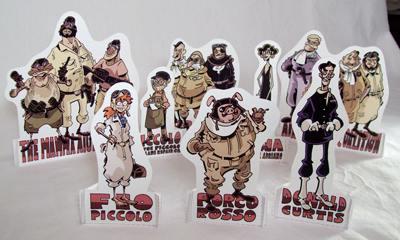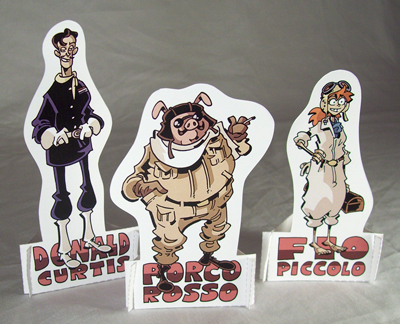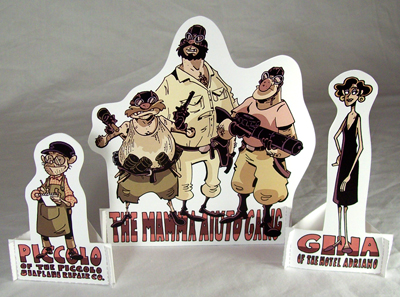Remember how, when I posted that guide to spotting tangents, I said that lesson two would be coming in a few days? Well, that was last October. Sorry. I've been REALLY busy.
Anyway, here’s a second lesson, one on three-plane composition.
If you’ve ever taken an art class, and likely if you’ve read any books on drawing, you’ve heard the term three-plane composition. If you haven’t, don’t worry! That’s what this post is for. For you folks who know it well, consider this a refresher.
The three planes are foreground (closest to the audience), midground (not really a word, but it should be, because “middle ground” is clunky and makes you think of ideological compromise, which ain't necessarily a bad thing but has no place here), and background, which is, well, the background. Farthest away. But it’s one thing to know what these things are, and another to understand why they work the way they do, how to use them and how to avoid problems when attempting to do so.

Think of it kind of like a diorama. ‘Cause that’s really what your image is, a diorama that you’re drawing. The frame of the image, be it a panel border or screen dimensions, is the box, and the stuff inside is the drawing. Each of these areas is called a “plane,” so you have a foreground plane, a midground plane, and a background plane. Anything that exists in the dimensional space of a given plane is considered part of that plane, so if there’s a guy driving a car in the midground then that guy is considered part of the midground, as is the car, and any other objects roughly the same distance from the reader.
Okay, so let’s look at this image.

It’s one guy standing close to the reader (or viewer, for you animators) in the foreground, another guy a bit farther away in the mnidground, and then, some distance behind him, a house in the background. Right?

Wrong. There’s absolutely nothing in the first image that precludes the possibility of the second. Why is that?
OVERLAP.
Whenever an object is closer to us (“us” being the reader) than objects on another plane, it needs to partially obscure those objects. It needs to OVERLAP them. This clearly indicates to the reader that one object is in front of another, and therefore nearer to the reader. If they don’t overlap, then you get situations like the big guy smashing the little guy into the tiny house, and nobody wants that.
Audiences aren’t dumb, but you never want them to have to stop and analyze an image to figure out what they’re looking at. We’re in the business of telling stories, and if your reader stops for an instant – the barest microsecond – to process what it is they’re supposed to be looking at, if their brain has to change tracks from following the narrative to interpreting an image… well, you’ve failed in your first priority, which is to tell a story and tell it clearly. Your audience will know that the bald guy isn’t giant and that the house is farther away, but by not using overlap to immediately present it as being so means that your reader might slow down for a second, and we can’t have that, no sir.

So here’s a solution, one that keeps the composition practically identical (fixes of this nature are not hard). By adding another element to the midground (in this case, a truck) and having midground guy physically interact with it, you are allowing foreground guy to overlap it. He doesn’t have to overlap midground guy, he just has to overlap SOMETHING in the midground. By having midground guy touch the truck, you’re showing that he’s on the same plane. And the bushes in front of the house? They now extend behind midground guy, making it clear that the house is in the background, because midground guy OVERLAPS it.
So why do we need three plane composition at all?
As I said, we’re in the business of telling stories. Three plane composition can make an image more visually arresting, sure, but that’s not why we do it. As storytellers, we do it because it allows us to fully engage the audience. This happens in two very important ways.

Okay, so here’s a quick sketch of a guy hacking his way through a dense jungle. The foreground plane, for your convenience, is colored dark purplish, the midground plane is sort of red, and the background plane is a light purplish.
Let’s focus on the foreground. That’s the real crux of the whole thing. You have to look PAST it in order to see the rest of the image. And that’s a really, really important thing. Looking past it forces you to engage the image.
You’re not REALLY looking past it. It’s a two dimensional image. You’re taking in the whole thing. But to your brain, you’re looking past something. You look past stuff all the time in real life. Ever take a picture in the woods and think it’s going to be beautiful, only to see it later and it’s just a big clump of green? That’s because your brain is constantly firing away, removing the visual obstacles in your path and processing that which you want to see. It can’t do that with pictures; it requires subtle movement on your part to get a three dimensional sense of what’s beyond the boring stuff. Your windshield. Unless it’s filthy, as mine often is, your mind is basically phasing it out, looking at what’s BEYOND it. And when you give your audience an image like this, that part of the brain kicks into gear, just because it’s so used to doing so. The reader doesn’t realize it, but his or her brain is working at solving a problem that isn’t there, which makes it FEEL like a challenging read, even though it’s really not. They don’t have to put forth any effort, so they’re never frustrated, but their brain is working extra, so they fell extra engaged.
That’s the unconscious part. There’s a conscious part, too. Or at least more conscious than that thing I just talked about.
By putting the foreground elements ON THE SAME PLANE AS YOUR READER, you’re making that reader a part of the image. It’s kind of like making a movie in 3D, only you didn’t have to spend millions and millions of dollars. If your audience could, were the image frame a window, reach through it and touch the foreground element, push it aside to get a better view of what’s behind it, then you’re engaging your audience by bringing the image to THEM.
It also creates spatial depth, a believable world, and all that jazz, but I think the audience engagement thing is far more interesting and discussed less frequently.
Okay, so if that’s an important role for the foreground, then it creates a RULE for the foreground, at least for me. Three distinct spatial differences does not make for a good three plane composition, not if you want that audience engagement.

The guy in the image immediately above is close, but not close enough to be on the same plane as the reader. We’re seeing this “foreground” character from a good ten feet away, and that’s too far, in my opinion, to be an effective foreground element.

There’s an AMAZINGLY well-drawn book by French artist Riff Reb, a comic adaptation of Pierre Mac Orlan’s A Bord de L’Etoile Matutine. It illustrates this point. Here’s one of the panels:

The soldier in the “foreground” is barely of a midground scale, so far as I’ve reckoned it. This means that the depth of the image is minimized, and there are few if any examples in the book in which there is a foreground element on the same planbe as the reader; most fall into this at-a-distance category. I’m not all that familiar with Riff Reb’s other work, but I believe this to be intentional, a narrative device. The book is paraphrasing a journal, and thus the tale finds its audience not through a participant but through the tale’s audience, so it is once removed from those involved by the time it reaches us. Eliminating a close foreground element whenever possible serves to amplify that effect that we as the collective reader are an outsider, NOT “in” the scene but observing it through the lens of time. While this is not something you want to do unintentionally, it goes to show that every “rule” can be broken if you’ve got a good narrative reason, and an understanding of why you’re choosing to break it and the effects that doing so will have on the reading experience.
So, if you want that foreground element to really pop, to really give your reader a chance to feel that he or she is “in” the story, make sure that it meets two criteria:
- The reader could touch it were the image frame (panel border or screen edge) a window (i.e. the object is on the reader’s plane of existence)
- The object is cropped by at least two sides of the image frame.

This second point further bolsters that sense of “looking past” and forces you to keep that object as close as possible.
That's certainly not all that can be said about three-plane composition, and I'm not really delving into the midground and background planes much, but that's because (a) I've got to leave for school in a few minutes, and (b) foreground seems to be the area with which folks have the most trouble. Hope you find this useful!



